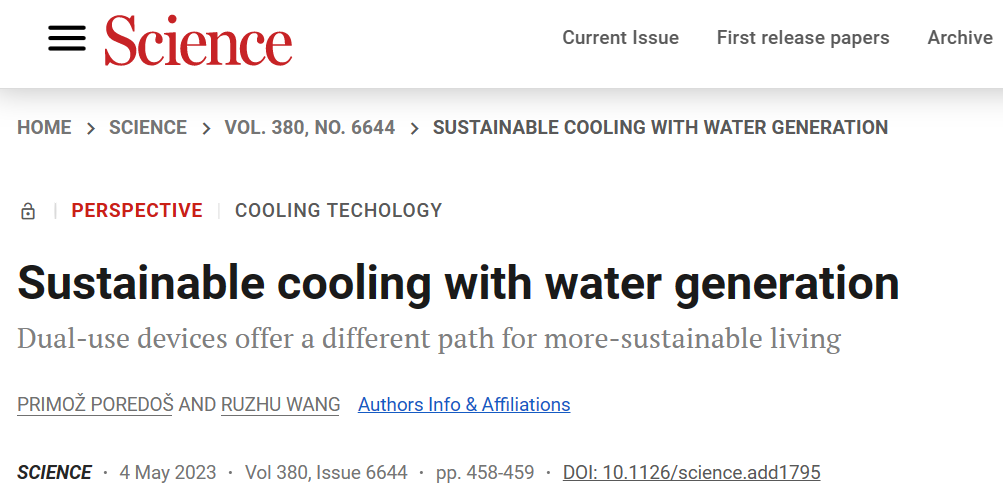
News

News
The world is facing a severe challenge to limit the global average temperature increase below 2 °C, preferably to 1.5 °C. Amidst the drive towards reduced energy consumption and technologies for CO2 management, the impacts of climate change on droughts and water scarcity are getting more and more severe. Researchers from School of Mechanical Engineering at Shanghai Jiao Tong University are proposing a conceptually new idea in a study published on May 5 in the journal Science to simultaneously cool the air and generate water from the atmosphere in places that are both hot and dry.

“Dry and warm places pose a real challenge for us researchers owing to their ambient characteristics, i.e., extremely high ambient temperatures and low moisture in the air,” says senior author Prof. Ruzhu Wang from School of Mechanical Engineering at Shanghai Jiao Tong University, who is active in research related to atmospheric water generation and materials that can passively cool itself. “We had to look at existing technologies and properties of such places. Then, we realized how certain technologies could benefit if combined in the right way from a holistic point of view when placed in such harsh conditions”.
To make the idea as versatile as possible, the authors proposed a combination of three technologies on a system level. The first is related to hygroscopic materials that can attract water vapor at ambient or sub-ambient temperatures from the air and release it under elevated temperature by using solar thermal or heat pump heating. When gaseous water molecules are attached to these materials, heat is released. In addition, for comfortable air-conditioning, the temperature of the air needs to be cooled as well. Hence, the authors proposed cooling energy generation using two approaches. The first one is entirely passive, owing to the unique optical properties of photonic materials that can simultaneously reflect sun rays while ejecting heat to the cold universe. “The heat rejection using these materials works very well in places with low moisture in the atmosphere, which is beneficial for dual-use devices in such ambients,” says Dr. Primož Poredoš, the first author of this paper.

The other source of cooling energy can be provided by heat pumps, where heat from above mentioned heat sources is pumped to the high-temperature heat sink. “Heat pumps allow us to purposefully use the pumped heat, i.e., to eject the stored water in hygroscopic materials that are full of water if we add heat at high temperature,” explains Dr. Poredoš. The primary purpose of hot vapor generation is to increase its dew point temperature significantly higher than the ambient temperature, thus generated water vapor could condense easily, perhaps only using ambient conditions. Similar conditions can be observed when cooking, where vapor mist condenses on the metal surfaces all around us. “In addition, the water release process can also be easily coupled with a solar thermal collector,” adds prof. Wang, “since warm and dry places are typically abundant with the sun radiation”.
The proposed concept needs to be addressed from the point of view of actual prototypes to the comparison with stand-alone devices that produce water and conditioned air. “Atmospheric water harvesting is a very attractive way to produce freshwater anywhere, anytime. However, thermal engineering scientists must seek a way to combine this technology with other technologies that are used every day in our lives”, says Prof. Wang. Various research teams might propose their own devices, “which then need to be evaluated according to how much the material is needed, what is the overall costs, and how much space such a dual-use device requires.” Looking ahead, integrating atmospheric water harvesting with other technologies is obviously needed, from the monetary aspect, especially to gain further attraction among stakeholders and policymakers.
Immense progress in material and thermal science brought us exceptional novel hygroscopic materials and daytime radiative sky cooling coatings. Both exceptional energy materials may be integrated with desiccant-based heat pumps. “Our predecessors produced fresh water and cold by ice harvesting from frozen lakes using primitive tools. Their inspiration serves as a reminder that the dual-use nature of devices is right at our fingertips, given the abundance of sophisticated equipment at our disposal,” concludes Prof. Wang.
Paper Link: https://www.science.org/doi/10.1126/science.add1795

Shanghai Jiao Tong University
Address: 800 Dongchuan Road, Shanghai
200240